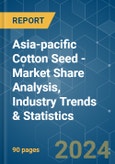The Asia-pacific Cotton Seed Market size is estimated at USD 1.10 billion in 2024, and is expected to reach USD 1.52 billion by 2030, growing at a CAGR of 5.54% during the forecast period (2024-2030).
Key Highlights
- Hybrids is the Largest Breeding Technology: Bt-cotton is the most used trait. The factors such as high yielding, insect resistant, herbicide-tolerant, and high fiber strength are the major drivers for hybrid seed.
- China is the Largest Country: Globally, China is the leading producer of cotton and has increased productivity due to an increase in the use of hybrid seeds and intensive cultivation practices.
- Hybrids is the Fastest-growing Breeding Technology: The major countries producing cotton are China and India. These countries have a high adoption rate for hybrids due to high yield, and resistance to insects and pests.
- Thailand is the Fastest-growing Country: The increase in area cultivated, government measures for increasing cultivation, and growing demand for fibers globally are helping in the growth of the market in Thailand.
Asia-pacific Cotton Seed Market (seed For Sowing) Trends
Hybrids is the largest Breeding Technology
- In Asia-Pacific, hybrid seeds dominated the cotton seed market in terms of volume and value compared to open-pollinated varieties and hybrid derivatives. In 2021, hybrid cotton seeds held 69.5% of the share value in the total cotton seed market.
- In the hybrid seed segment, transgenic hybrid seeds dominated the market in the region with 82.2% of the share value in 2021, mainly due to the scope of environmental, social, and economic benefits, as these seeds reduce the usage of pesticides, increase yields, minimize environmental pollution, and reduce labor and cost.
- In transgenic cotton hybrids, insect-resistant hybrids are highly cultivated and hold more than 99.0% of the total share of the transgenic cotton market. Insect-resistant cotton hybrids help in reducing insect attacks (especially lepidopteran insects), thus reducing pesticide usage and increasing yields.
- In the case of non-transgenic cotton seeds, the market share is very less compared to transgenic seeds, mainly due to reduced cultivation in many countries of the region. In 2021, it held a 17.8% share in the total cotton hybrid seed market as the transgenic seeds are helping minimize the loss of farmers through insect-resistant characteristics.
- Open-pollinated varieties and hybrid derivatives of cotton seeds hold 15.5% of the market share in the region. These are the local seeds specific to the region, having low yield characteristics compared to hybrids.
- Therefore, due to such factors, hybrid cotton seeds are highly cultivated in the region, and they are anticipated to register a CAGR of 4.4% during the forecast period.
China is the largest Country
- In the Asia-Pacific region, the cotton seed segment is primarily driven by the demand for cotton in the textile industry. China dominated the region’s cotton seed market and accounted for 27.4% of the global market share in 2021.
- China is the largest cotton-producing country in the world after India, with an annual production of 6,178 thousand metric ton. The country largely follows intensive cultivation practices, which increased the production per ha, the highest in the world, with 1,400 kg/ha after Brazil.
- In 2021, due to reduced production and the COVID-19 pandemic, the Indian cotton segment was affected badly. There was an increasing MSP (minimum support price) for medium-staple cotton from USD 66 to USD 69 per quintal and long-staple cotton from USD 69 to USD 73 per quintal in season 2020-2021, which is expected to boost the market's growth during the forecast period.
- In Pakistan, the area under cotton cultivation was 2.1 million ha in 2020, which accounted for 9.9% of the total Asia-Pacific cotton area. According to the USDA, the cotton area is expected to increase in Pakistan during the marketing year 2022/23, driven by value-added cotton textile exports and taxation and energy policy to support the textile sector. Therefore, the increasing area is expected to drive the cotton seed market in the future.
- Therefore, increasing demand from the textile industry, high export potential of cotton textiles, and higher dependency on imports are the major factors anticipated to boost cotton production in the country, thereby boosting the growth of the seed market during the forecast period.
Asia-pacific Cotton Seed (seed For Sowing) Industry Overview
The Asia-pacific Cotton Seed Market (seed For Sowing) is fragmented, with the top five companies occupying 10.30%. The major players in this market are Bayer AG, JK Agri Genetics Ltd (JKAL), Maharashtra Hybrid Seeds Co. (Mahyco), Namdhari Seeds Pvt. Ltd. and Nuziveedu Seeds Ltd (sorted alphabetically).Additional Benefits:
- The market estimate (ME) sheet in Excel format
- 3 months of analyst support
Table of Contents
1 EXECUTIVE SUMMARY & KEY FINDINGS2 REPORT OFFERS7 KEY STRATEGIC QUESTIONS FOR SEEDS CEOS
3 INTRODUCTION
4 KEY INDUSTRY TRENDS
5 MARKET SEGMENTATION
6 COMPETITIVE LANDSCAPE
8 APPENDIX
Companies Mentioned (Partial List)
A selection of companies mentioned in this report includes, but is not limited to:
- Bayer AG
- DCM Shriram Ltd (Bioseed)
- JK Agri Genetics Ltd (JKAL)
- Kaveri Seeds
- Krishak Bharati Co-Op Limited (KRIBHCO)
- Maharashtra Hybrid Seeds Co. (Mahyco)
- Namdhari Seeds Pvt. Ltd.
- Nuziveedu Seeds Ltd
- Rallis India Limited
- Rasi Seeds (P) Ltd.
Methodology

LOADING...










